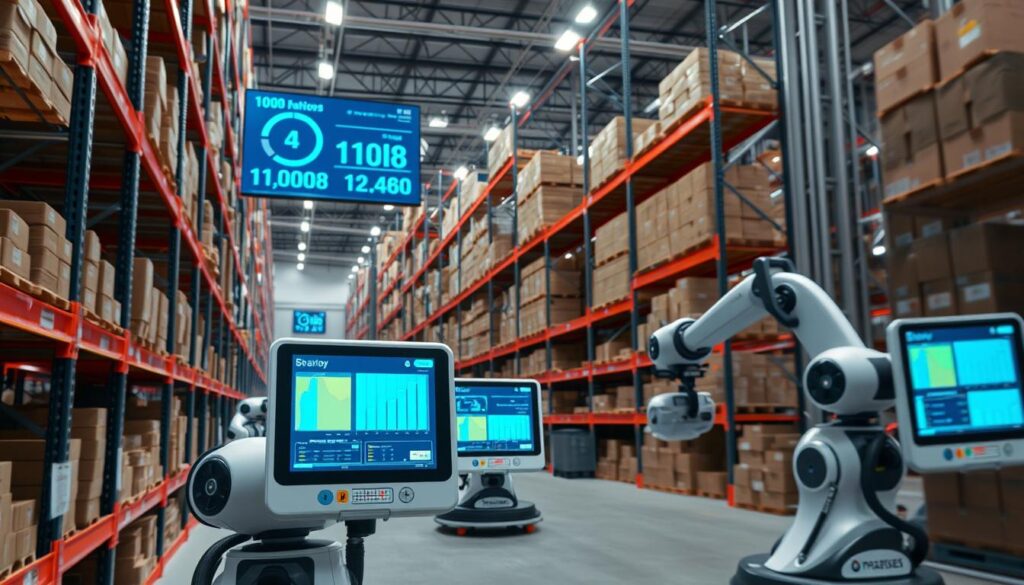In today’s quick-moving market, automating inventory management is essential, not just a plus. Systems like Brightpearl lead in giving smooth control over stocks and distribution. They make retail and wholesale management better. They do this by optimizing operations and offering real-time control. This full automation handles tasks such as dropshipping and backorders, plus order invoicing. It also manages customer tagging and keeps accurate inventory counts. This reduces chances of mistakes and problems that come with manual methods like Excel.
Using these advanced systems helps businesses work with more accuracy and efficiency. This leads to more profits and smoother workflows. Automated inventory management systems help in making smarter decisions quickly. This avoids problems like running out of stock. Whether it’s dealing with thousands of sales daily or mixing physical and online sales, tools like Brightpearl are crucial for modern retailers.
Key Takeaways
- Automated inventory solutions save a lot of time, freeing up months that would be spent on manual work.
- Managing inventory in real-time with automation helps businesses make timely decisions, avoiding stock shortages.
- Automation improves the accuracy of stock levels and transactions. This allows companies to manage large volumes without mistakes.
- It also increases efficiency in order fulfillment and predicting customer needs. This, in turn, makes customers happier.
- The great thing about automated systems is their ability to scale and adapt. They work well with ERP systems and support company growth.
Understanding the Importance of Inventory Management
For businesses to work better and keep customers happy, managing stock is vital. By using inventory control automation, they can make their operations smoother. This part talks about how managing stock affects businesses and the problems they face in today’s market.
The Role of Inventory in Business Operations
Stock is key in supply chain operations, touching production, sales, and finances. By using inventory tracking systems, companies make sure goods move smoothly from getting them to selling them. Tools like Brightpearl give real-time info on stock levels, which helps with better operations and smart decisions across sales channels.
Take Apple, for instance. They cut down stock turnover times to just days. This made their operations way more efficient and cut costs.
Common Inventory Management Challenges
Inventory is crucial in business, but handling it brings challenges. Mistakes with manual inputs and poor tracking can mess up a lot, from trust with customers to financial reports. Also, using inventory optimization software is key to fix these by tracking and managing stock accurately.
- Manual stock tasks can slow down operations and cause money loss.
- Different systems for sales channels can mess up stock data.
- Automated systems prevent having too much or too little stock by using past data to know when to order more.
With advanced inventory management solutions, companies can beat these challenges. This improves how well and sustainably they operate.
Key Benefits of Automating Inventory Management
In today’s fast-paced market, businesses are turning to advanced digital inventory solutions. These systems streamline operations. Companies enhance operational efficiency and get significant benefits in inventory management by using automation.
Improved Accuracy and Reduced Errors
Automated inventory management systems cut down on human errors. This occurs in manual processes. By doing so, businesses have a reliable base for their decisions. The use of AI and machine learning in inventory systems boosts efficiency. This creates a self-correcting system that keeps inventory tracking accurate in real-time.
Enhanced Decision-Making and Forecasting
Efficient inventory management helps businesses make informed decisions. They use deep insights and data analytics from automation. With real-time data, companies can quickly meet inventory needs, improving forecasting accuracy. Predictive analysis allows businesses to predict market trends, adjust stock levels, and meet demands without overstocking or running out.
The strategic use of automation in inventory processes leads to a higher return on investment for many businesses. Advanced reporting features let businesses continuously improve their inventory practices to suit changing market conditions.
| Feature | Impact |
|---|---|
| Real-Time Inventory Tracking | Ensures up-to-date stock information, reducing the chance of sales loss due to out-of-stock situations. |
| Automated Reordering | System-generated notifications for low stock levels help maintain optimal inventory, preventing over and under stocking. |
| Data Analytics | Provides actionable insights for better decision-making, optimizing stock levels based on consumption patterns. |
| Cost Management | Accurate inventory records minimize holding costs by avoiding unnecessary stock accumulation. |
As businesses grow, digital inventory solutions ensure scalability and sustainability. By automating inventory management, companies save time and boost efficiency. This leads to growth and a competitive edge in the market.
Technology Solutions for Inventory Automation
The way we handle inventory in e-commerce and stores has changed a lot. Now, we use inventory automation tools like advanced software and cool gadgets. These include barcode scanners and RFID technology. They make sure we can track and manage products easily across different places.
Inventory Management Software Options
By using automated inventory tracking, businesses become more efficient and make fewer mistakes. The right software keeps track of everything in real-time. This means always knowing how much stock you have, what orders are coming in or out, and where shipments are. Automation does most of the work, like placing orders for more inventory. It even predicts how much stock you need. Learn more about how inventory automation can change the game for you.
Barcode and RFID Technology
RFID and barcode tech are leading the way in better inventory management. They make automated systems way more efficient. For instance, RFID tech can speed up counting inventory by 15 times. Plus, it lets you know exactly where every item is in real-time.
This tech not only makes inventory checks faster but also cuts down on mistakes. With RFID tags, you can adjust your stock levels right away. This greatly reduces the chances of having too much or too little stock.
| Feature | Impact |
|---|---|
| Automated Order Replenishment | Up to 99% of purchase orders managed automatically. |
| RFID Implementation | Allows 15x faster stock counting and 100% inventory visibility. |
| ROI Potential from Automation | Can reach up to 300%. |
| Development Cost for Custom Solutions | Ranges from $90,000 to $400,000 depending on complexity. |
| Implementation Timeframe | Typically 8–12 months. |
Integrating Automation with Existing Systems
To streamline inventory management well, it’s key to blend automation with current systems. This blend makes new inventory optimization software and old IT setups work better together. It boosts efficiency without messing up what’s already there.

Seamless integration means new tech boosts and works well with old software. Things like POS, CRM, and e-commerce get better. For those using systems like Celona’s 5G LAN, merging is smooth and natural. It fits current tech setups perfectly.
Ensuring Compatibility with Other Software
Finding inventory control automation software that matches your current tech is vital. If they don’t match, it causes big problems at start and during everyday work. More companies now want software that works well with many systems. This makes mixing them easier.
Many top software companies give great guides and help. They make sure their systems can blend well with what you already have.
Data Migration Best Practices
When bringing in new tech, moving data right is crucial. Doing it correctly keeps your data safe and prevents loss. Key steps include checking data first, matching data fields correctly, and doing test runs.
For more tips, check out process improvement solutions. They have detailed advice and expert opinions.
| Feature | Importance |
|---|---|
| Real-time Synchronization | Ensures continuous operational flow with no data lags |
| User Compatibility | Reduces training time and enhances user adaptability |
| Scalability | Allows the system to grow with business needs |
| Support and Maintenance | Provides ongoing support to address potential integration issues |
Best Practices for Implementing Automation
Starting with an automated inventory management system requires careful planning. This helps make everything work smoothly in your business. Here we share key steps for a successful inventory process automation.
Conducting an Inventory Audit First
Firstly, check your stock levels with a detailed audit. This step finds any issues to fix right away. Knowing exactly what you have helps set goals for the automated inventory management system, aiming for better efficient inventory management.
Training Employees for a Smooth Transition
Employees play a key role when bringing in new tech. Training them to use the new automated inventory management system is crucial. Good training lets your team make the most of the system, improving work efficiency from the start. Keep teaching them about new features to stay up-to-date.
Focus training on the software’s interface, interpreting system data, and solving common problems. This helps employees use the system well and share improvement ideas.
Automation in efficient inventory management makes everything run better, adds accuracy, and provides control. By following these practices, businesses manage their inventory well. This leads to better operations, lower costs, and happier customers.
Measuring the Success of Automation
Businesses are moving forward with efficient inventory management strategies and inventory optimization software. This move is key to getting more modern and improving efficiency. After these digital inventory solutions are in place, it’s important to check how successful they are. We do this by looking at different measures and performance indicators.
Key Performance Indicators to Track
Tracking the success of inventory automation is done through key performance indicators (KPIs). Here are some important ones:
- Inventory Turnover: Aim for an overall turnover rate more than 1.0 and above 3.0 without critical spares. This is suggested by the Society for Maintenance & Reliability Professionals.
- Stock Outs: This is the ratio of stock outs to monthly or annual sales. It shows how well the supply chain works.
- Inactive Stock: Look at non-critical stock that isn’t used. This helps find too much inventory and may reduce costs.
- Carrying Cost of Inventory: This checks how much working capital is in inventory and its costs like obsolescence and how well the warehouse is managed.
- Order Cycle Time: This measures how long it takes from placing an order to getting it. It checks inventory management and order filling speed.

Gathering Feedback for Continuous Improvement
For digital inventory solutions, we need to look at numbers and listen to people. Feedback from workers and customers is key. It makes the inventory optimization software better. This ensures it meets what users want and follows market needs.
Looking at automation includes more than just costs. It involves complex parts like AI, machine learning, and others. Understanding this wide effect of automation is crucial. This keeps the system effective as efficient inventory management changes. Staying updated with these measures and feedback keeps businesses competitive in a digital world.
Future Trends in Inventory Management Automation
The way we manage inventory is changing fast, thanks to new technology. Artificial Intelligence (AI) and machine learning are at the forefront. They’re changing stock management in big ways. AI helps in avoiding too much or too little stock. This makes customers happier and cuts costs.
AI and Machine Learning in Inventory Control
AI and machine learning make inventory management more precise and audit accuracy higher. When humans might make errors, machine learning comes in with detailed stock data. Moreover, Internet of Things (IoT) devices are becoming key in automating inventory processes. They provide real-time tracking for up-to-date inventory information.
The Influence of E-commerce on Inventory Practices
E-commerce has greatly impacted inventory management. There’s a growing need for advanced, automated systems. These systems handle sales from many channels efficiently. They are crucial for success online. Additionally, blockchain brings new levels of transparency and security. It makes every transaction traceable and safe. Looking ahead, businesses must continually improve their inventory practices to stay competitive and meet higher customer expectations.
FAQ
What are the primary goals of automating inventory management processes?
The main goals include streamlining operations, increasing efficiency, and enhancing inventory control. Automation saves time, cuts down on mistakes, and helps businesses make better decisions.
Why is inventory management crucial for businesses?
It’s critical for keeping track of stock, managing supplies, and overseeing sales. This is true for online and physical stores. It ensures products are always available, keeping customers happy.
What are some common challenges faced in inventory management?
Some challenges are errors from manual input, inefficient tracking, and uncoordinated control across sales channels. These issues can cause stock mismatches and potential losses in sales and revenue.
Can you outline the key benefits of automating inventory management?
Benefits of automation include greater accuracy and fewer manual errors. It also improves decision-making with real-time data, better forecasting, and allows operations to scale.
What are some cutting-edge inventory automation tools available?
Cutting-edge tools include Artificial Intelligence, Machine Learning, and advanced software like Celona’s 5G LAN. RFID tags and IoT sensors also play a key role in enhancing inventory control and tracking.
What is the significance of integrating automation systems with existing software?
Integrating new systems with current ones, like POS, CRM, and e-commerce platforms, is key. It keeps data synchronized across all IT infrastructure, boosting inventory automation efficiency.
What factors should be considered while implementing an automated inventory management system?
Key factors include performing an inventory audit, ensuring compatibility with existing operations, and training staff thoroughly. These steps are vital for a smooth transition and minimizing issues.
How do businesses measure the success of inventory automation?
Success is gauged using KPIs such as order fulfillment accuracy, inventory turnover, and customer satisfaction. Getting ongoing feedback from staff and customers is crucial for refinements.
What are future trends in inventory management automation?
Future trends involve using AI and Machine Learning for better control and predictive analytics. Also, developing systems that handle e-commerce and multichannel retailing effectively is key.



